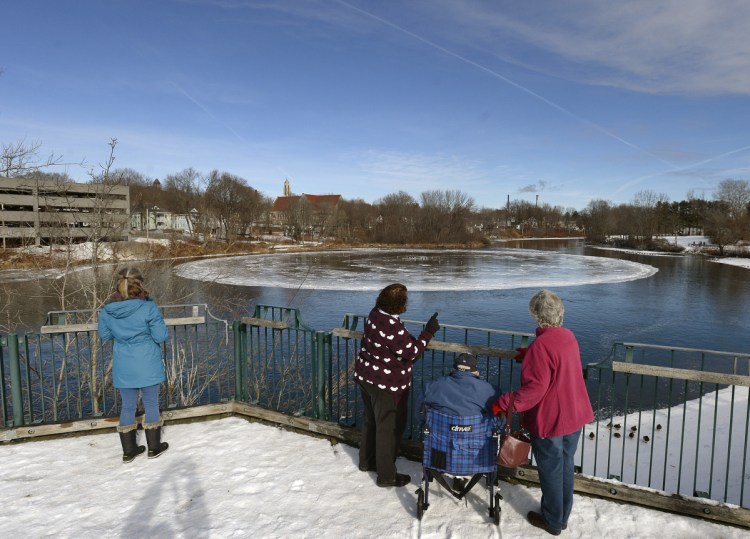It’s aliens. It’s magic. It’s an ice moon. It’s a metaphor for life, and the drab winter days that follow New Year’s.
Of course it is none of those things, objectively speaking. It is frozen water, and it’s spinning on top of the Presumpscot River in Westbrook.
A mysterious ice disk, at 100 yards wide, continued its methodical counterclockwise rotation on the surface of the river Tuesday, unperturbed by landing birds or the people who came to the river to see for themselves how round and rotating it really was.
So why is it there, and how did it form?
Good answers are not easy to find. The spinning ice disk, as a phenomenon, remains relatively unexamined by science. But we are not the first to stare and wonder.
Rotating ice disks have been reported in the U.S. since at least 1895, when Scientific American, in an item squeezed between articles on lifesaving balloons and street-car fenders, published a short submission from a Bedford, New York, man who spotted a disk lazily turning in the river.
Spinning disks of varying size appear periodically during winter months in colder climates in North America and Europe, and have been the subject of speculation for years, appearing in rivers and streams but never lakes or ponds. In fact, a similar spinning disk appeared this month in rural Estonia and has been drawing curious onlookers to the shore of the Vigala River.
“It’s a pretty serious fluid-dynamics problem, and fluid dynamics is pretty complicated,” said Paul Nakroshis, associate professor of physics at the University of Southern Maine.
Nakroshis does not specialize in fluids, but he’s read the scant literature available: a paper published in 2016 about why the disk spins, along with a smattering of theories bandied about in 1993, when an ice disk formed in the Charles River in Massachusetts, prompting MIT’s science community to gawk and theorize.
“A whole bunch of people at MIT were speculating,” Nakroshis said. “They were hypothesizing these crazy theories on how it forms.”
The recent research was conducted at the University of Liege in Belgium, where a team led by Stéphane Dorbolo showed that temperature changes in the water below a small ice disk could be the source of some of the rotational force.
The effect has to do with a unique property of water, Nakroshis explained. While most substances are most dense in their solid or frozen state, water is most dense around 39.2 degrees Fahrenheit, or 4 degrees Celsius. At freezing – 32 degrees Fahrenheit or 0 degrees Celsius – the density goes down, and that’s why ice floats.
Dorbolo’s team theorized that as the ice melts, it cools the relatively warm water directly beneath the ice sheet. When the cooling water reaches 39.2 degrees, it begins to sink and creates an unseen vortex in the water column, producing a small force that spins the ice floe. Slowly moving river water is believed to help get it started.
The researchers replicated the phenomenon in laboratory experiments conducted with roughly 4-inch disks of ice in a tank with temperature-controlled water.
The perfectly symmetrical shape of the disks may reflect the circular force of an underlying vortex, but also has been attributed to a shearing effect as the disks spin and come into contact with surrounding, stationary ice.
Nakroshis, meanwhile, was skeptical of extrapolating the results of the Belgian experiments directly to the conditions in the Presumpscot River in Westbrook.
He had a simpler theory: The flow of the river is pushing the ice disk along like a paddle wheel. While some of the vortex effect might influence the rotation, Nakroshis said he suspects the ice forms in clumps, begins to stick together and collects more ice as it goes.
The edges appear thicker than the center, Nakroshis said.
“Once it starts, something sticks to it and freezes to it and it just keeps growing,” he said. “There’s nothing supernatural about this, right?”
Matt Byrne can be contacted at 791-6303 or at:
Copy the Story LinkSend questions/comments to the editors.




Success. Please wait for the page to reload. If the page does not reload within 5 seconds, please refresh the page.
Enter your email and password to access comments.
Hi, to comment on stories you must . This profile is in addition to your subscription and website login.
Already have a commenting profile? .
Invalid username/password.
Please check your email to confirm and complete your registration.
Only subscribers are eligible to post comments. Please subscribe or login first for digital access. Here’s why.
Use the form below to reset your password. When you've submitted your account email, we will send an email with a reset code.